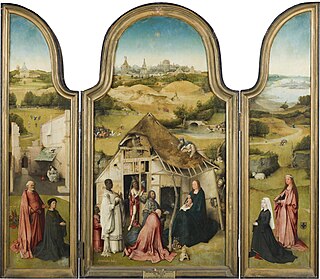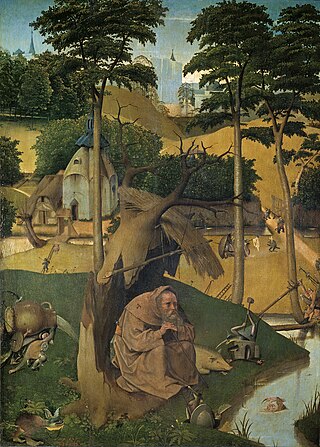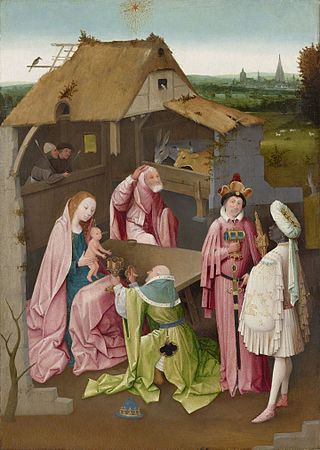Description
The painting's composition has similarities to The Last Judgment triptych in Vienna and The Garden of Earthly Delights : both show the Garden of Eden in the left panel and Hell at right.
As in other contemporary Flemish triptychs, the shutters are externally painted in grisaille with a Coronation with Thorns.
In the central panel is Christ as a judge within a celestial sphere, flanked by angels who are playing the Trumpets of Last Judgement, and by the apostles. Below him is the punishment of sinners which, like the Last Judgement of Vienna, continues in the Hell depiction at right. At left is Paradise, where the blessed souls are being shipped to Eden on a boat with a pink tent. The tower is a symbol of the Fountain of Eternal Youth, a more articulate version of which appears in the Garden of Delights.
The central panel is mostly occupied by insect-like demons who torture the men, with punishments that include burning, eating impure food (the gluttonous) etc., all inspired by Netherlandish Proverbs. The infernal city at right is under siege by demons, while a fire is visible in the far background.

Hieronymus Bosch was a Dutch painter from Brabant. He is one of the most notable representatives of the Early Netherlandish painting school. His work, generally oil on oak wood, mainly contains fantastic illustrations of religious concepts and narratives. Within his lifetime, his work was collected in the Netherlands, Austria, and Spain, and widely copied, especially his macabre and nightmarish depictions of hell.

Ship of Fools is a painting by the Early Netherlandish artist Hieronymus Bosch, now in the Musée du Louvre, Paris. Camille Benoit donated it in 1918. The Louvre restored it in 2015. The surviving painting is a fragment of a triptych that was cut into several parts. This piece, originally part of a larger body of work relating to the seven deadly sins, depicts the sin of gluttony. The Ship of Fools was painted on one of the wings of the altarpiece, and is about two-thirds of its original length. The bottom third of the panel belongs to Yale University Art Gallery and is exhibited under the title Allegory of Gluttony. The other wing, which has more or less retained its full length, is the Death and the Miser, now in the National Gallery of Art, Washington, D.C. The two panels together would have represented the two extremes of prodigality and miserliness, condemning and caricaturing both. The Wayfarer (Rotterdam) was painted on the right panel rear of the triptych. The central panel, if it existed, is unknown.

The Groeningemuseum is a municipal museum in Bruges, Belgium, built on the site of the medieval Eekhout Abbey.

The Garden of Earthly Delights is the modern title given to a triptych oil painting on oak panel painted by the Early Netherlandish master Hieronymus Bosch, between 1490 and 1510, when Bosch was between 40 and 60 years old. Bosch's religious beliefs are unknown, but interpretations of the work typically assume it is a warning against the perils of temptation. The outer panels place the work on the Third Day of Creation. The intricacy of its symbolism, particularly that of the central panel, has led to a wide range of scholarly interpretations over the centuries.

The Haywain Triptych is a panel painting by the Early Netherlandish painter Hieronymus Bosch, now in the Museo del Prado, Madrid, Spain. A date of around 1516 has been established by means of dendrochronological research. The central panel, signed "Jheronimus Bosch", measures 135 cm × 200 cm and the wings measure 147 cm × 66 cm. The outside shutters feature a version of Bosch's The Wayfarer.

The Conjurer is a painting by Early Netherlandish painter Hieronymus Bosch or his workshop, executed around 1502.

The Adoration of the Magi or The Epiphany is a triptych oil painting on wood panel by the Netherlandish artist Hieronymus Bosch, executed around 1485–1500. It is now in the Museo del Prado in Madrid, Spain.

The Last Judgment is a triptych created by a follower of Hieronymus Bosch. Unlike the other two triptychs with the same name, in Vienna and in Bruges, only a fragment of this one exists today. It resides at the Alte Pinakothek in Munich.

Christ Carrying the Cross is a painting attributed to a follower of Hieronymus Bosch. It was painted in the early 16th century, presumably between 1510 and 1535. The work is housed in the Museum of Fine Arts in Ghent, Belgium. The painting is notable for its use of caricature to provide grotesque-looking faces surrounding Jesus.

St. Jerome at Prayer is a painting of St. Jerome by the Netherlandish artist Hieronymus Bosch, thought to have been completed c. 1482. Today it is housed at the Museum of Fine Arts in Ghent.

The Crucifixion of Saint Wilgefortis is a c. 1497 triptych by the Early Netherlandish painter Hieronymus Bosch. The subject of the painting has been uncertain, and it has also been known as the Triptych of the Crucified Martyr, or The Crucifixion of Saint Julia, but is now believed to depict Saint Wilgefortis.

The Hermit Saints is a religious oil on panel painting displayed as a triptych which was painted c. 1493 by the Early Netherlandish artist Hieronymus Bosch. The entirety of the triptych painting measures 86 by 60 centimetres. This artwork is currently being housed at the Gallerie dell'Accademia, Venice.

The Temptation of St. Anthony is a painting of disputed authorship, attributed to either the Early Netherlandish artist Hieronymus Bosch or a follower. It is now in the Museo del Prado, in Madrid.

The Last Judgment is a triptych by the Early Netherlandish artist Hieronymus Bosch, created after 1482.
The Last Judgment is part of the eschatology of the Abrahamic religions and in the Frashokereti of Zoroastrianism.

The Fall of the Rebel Angels is an oil-on-panel painting of 1562 by the Netherlandish Renaissance artist Pieter Bruegel the Elder. The painting is 117cm x 162cm and is now in the Royal Museums of Fine Arts of Belgium in Brussels, Belgium. The Fall of Rebel Angels depicts Lucifer along with the other fallen angels that have been banished from heaven. Angels are falling from the sun in a stacked manner along with ungodly creatures that Bruegel created. This piece by Bruegel was previously thought to be by Hieronymus Bosch. Bruegel was influenced by a variety of artists such as Albrecht Dürer, Frans Floris I, and Hieronymus Bosch. He also got ideas for the creation of his creatures in his previous works.

The Triptych of Temptation of St. Anthony is an oil painting on wood panels by the Early Netherlandish painter Hieronymus Bosch, dating from around 1501. The work portrays the mental and spiritual torments endured by Saint Anthony the Great, one of the most prominent of the Desert Fathers of Egypt in the late 3rd and early 4th centuries. The Temptation of St. Anthony was a popular subject in Medieval and Renaissance art. In common with many of Bosch's works, the triptych contains much fantastic imagery. The painting hangs in the Museu Nacional de Arte Antiga, in Lisbon.

The Adoration of the Magi is an oil painting on wood panel attributed to the workshop of Netherlandish artist Hieronymus Bosch, executed around 1499. It is housed in the Philadelphia Museum of Art, USA. The museum's catalog assign it to around 1518, as having been finished by Bosch's workshop. According to Dendochronologic research, it could have been painted in 1493–1499.

The Adoration of the Magi is an oil painting on wood panel by Netherlandish artist Hieronymus Bosch, executed around 1475. It is housed in the Metropolitan Museum, New York, US. A prominent feature of this painting is the strong perspective effect and also the copious use of gold leaf, which is not very typical for Bosch. The pigments employed are red lake, azurite, lead-tin-yellow and ochres.

The Flood Panels are two double-sided painted panels attributed to the Early Netherlandish artist Hieronymus Bosch, dating to c. 1514 and now in the Museum Boijmans Van Beuningen in Rotterdam.



















